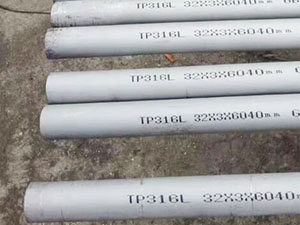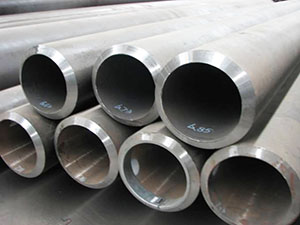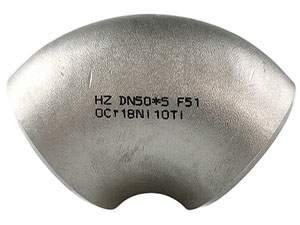Ti 6Al-4V is the most widely used of all the alpha-beta titanium alloys. It is typically used in the annealed condition, at service temperatures through 750°F. However it may be heat treated for high strength in sections under 4" thick. Hardenability is limited and sections over one inch may not develop full properties. Ti 6Al-4V is welded with matching or with ELI filler wire.
Mill anneal: 1300-1450°F 2 hours, air cool. Recrystallization anneal bar for better ductility and fatigue strength, 1750°F 2 hours, furnace cool.
For maximum fracture toughness and SCC resistance: Beta anneal 1950°F 1-2 hours, water quench. Then age 1150-1300°F 2 to 4 hours, air cool.
For maximum strength: solution-treated and aged (STA) condition is: For sheet, 1675-1725°F 5 to 25 minutes, water quench. Age 975°F 4 to 6 hours, air cool. For bars and forgings, 1675-1725°F 1 hour, water quench. Age 975-1025°F 3 hours, air cool.
For increased fracture toughness, but lower tensile strength: precipitation treat (overage) 1150-1250°F 4 hours, air cool. Stress relief annealing is commonly 1000-1200°F 1 to 4 hours, air cool.
Ti 6Al-4V is resistant to general corrosion but may be quickly attacked by environments that cause breakdown of the protective oxide. These include hydrofluoric (HF), hydrochloric (HCl), sulfuric and phosphoric acids. Inhibitors may help for the last four but not for HF. Ti 6Al-4V resists attack by pure hydrocarbons, and most chlorinated and fluorinated hydrocarbons (provided water has not caused formation of small amounts of HCl and HF).
Ti 6Al-4V is susceptible to chloride stress corrosion cracking (SCC), although being among the better of the titanium alloys in this regard. For marine environments silver plated bolts are not used, as silver bonds easily with chlorine in this environment. Ti 6Al-4V is also susceptible to SCC in environments such as methyl alcohol, red fuming HNO3, and N2O4. In the case of red fuming nitric acid, the problem is limited to environments containing less than 1.5% water, or more than 6% NO2. Failure in N2O4 has occurred when oxygen and chlorides were present as impurities.
Chemistry
|
|
Al
|
V
|
C
|
N
|
O
|
H
|
Fe
|
Y
|
Others,
Each
|
Others,
Total
|
Ti
|
|
MIN
|
5.5
|
3.5
|
--
|
--
|
--
|
--
|
--
|
--
|
--
|
--
|
--
|
|
MAX
|
6.75
|
4.5
|
0.08
|
0.05
|
0.2
|
0.0125
|
0.3
|
0.005
|
0.1
|
0.4
|
Balance
|
Specifications
AMS 4911, AMS 4920, AMS 4921, AMS 4928, AMS 4934, AMS 4935, AMS 4965, AMS 4967, AMS 6930, AMS 6931, AMS T-9046, AMS T-9047
ASME SB 265, ASME SB 348, ASME SB 861
ASTM B 265
ASTM B 348
ASTM B 381
ASTM B 861, ASTM F 1472
EN 3.7164
EN 3.7165
MIL-T-9046
MIL-T-9047
UNS R56400
Werkstoff 3.7164, Werkstoff 3.7165
Inventory
6Al-4V Forged Billet, 6Al-4V Plate, 6Al-4V Rectangular Bar, 6Al-4V Round Bar, 6Al-4V Sheet, 6Al-4V Weld Wire
Common Trade Names
6-4 Titanium, 6-4, Ti 6-4
Features
• High strength to 600°F
• Excellent general corrosion resistance
• High strength-to-weight ratio
Applications
• Turbine blades, discs and rings
• Aircraft structural components
• Weapons structural components
• Fasteners
• Medical and dental implants
• Hand tools
• Sporting equipment
• Chemical process equipment
Physical Properties
Density: 0.160 lb/inch3
Melting Range: 2929 - 3020°F
Beta Transus: 1825± 25°F
|
Temperature, °F
|
70
|
200
|
400
|
600
|
|
Coefficient of Thermal Expansion, in/in°F x 10-6
|
-
|
5.3
|
5.4
|
5.5
|
|
Thermal Conductivity,
Btu • Ft/Ft² • Hr°F STA
|
4.0
|
4.3
|
5.2
|
6.1
|
|
Modulus of Elasticity,
psi X 106 STA
|
16.7
|
16.0
|
15.0
|
14.0
|
Mechanical Properties
Specified, AMS 4911, annealed sheet & plate
|
|
Anneal 1300°F, Air Cool
|
Anneal 1300°F, Solution anneal 1750°F , Age 1000°F
|
|
Ultimate Tensile Strength, ksi
|
138-155
|
150-172
|
|
0.2% Yield Strength, ksi
|
128-147
|
137-156
|
|
Elongation, %
|
15-20
|
15-17
|
|
Reduction of Area, %
|
38-51
|
41-46
|
Typical Tensile Strength and Fracture Toughness, Various Heat Treatments for Flat-rolled Products (MCIC-HB-02 1985 reprint)
|
|
0.2% Yield Strength, ksi
|
Fracture Toughness K1C, ksi √in
|
|
Annealed
(Continuously Rolled Sheet)
|
132
142 (transversea)
|
128
140 (transversea)
|
|
Beta Annealed (plate)
|
131
|
134
|
|
Beta STA 1250°F b
|
128
|
150
|
|
Beta STA 1000°F b
|
143
|
120
|
|
STA 1250°Fc
|
137
|
105
|
|
STA 1000°Fc
|
159
|
80
|
(a) Directional variations,
(b) Beta heat treated followed by solution treating and overaging 1250˚F, or aging 1000˚F
(c) Solution treating and overaging 1250˚F, or aging 1000˚F





